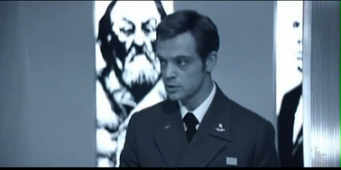Anri Berton (Vladislav Dvorzhetskiy) is a vital character at the beginning of the movie because he was the man who went on the earlier space journey. Dr. Kelvin was going to go on the space journey Berton previously went on and he watched Berton’s testimony of his findings during his journey. Like many of the other doctors, Dr. Kelvin, despite Beton’s persuasion, does not believe the testimony Berton gave holds true. Some of his testimony matched up with what the camera had caught during the journey, except for one unbelievable image. Berton claims that that he saw an infant that was almost four meters tall floating in the ocean. Despite constant belief that the image was real, all of the doctors come to the conclusion that he was hallucinating and dismissed that part of the report. The doctors went to the camera to see if there was evidence of a child but all that was seen was clouds and the surface of the ocean. Shortly before Berton embarks for his journey, he receives a message from Berton explaining that the child he claimed to have seen showed resemblance to the child of a scientist from the journey.
Even though Berton only plays a role at the beginning of the movie in a couple scenes, one can gather that he has an understanding of his reality through his experiences. Berton uses these experiences as evidence of his knowledge and they are these perceptions of what he sees and what others think about his findings. His knowledge of reality shows some strong resemblances to William James’ ideas, a pragmatist who developed the idea of perspectivism. James believed that there was not one universal truth or theory but at the same time truth was not relative to human beings. Along with this ideology comes the notion that there is not one unified truth because people’s perspectives can be in conflict, and this is shown in the movie. The camera picked up certain images and from those images the truth would be that all that was seen were clouds and oceans. However, from Berton’s perspective there was more than just ocean or clouds and his truth is in conflict with the truth from the camera so one theory cannot be formed. The difference in perspectives shows why James believes that the truth is always changing because the more perspectives there are on a particular subject, the more the view of one can change. James might also attribute the vision of a four-meter child to the feelings of Berton. James thought that people’s experiences change based on their feelings. Berton said the child resembled the child of a lost scientist so if Berton was feeling sorrow for the lost scientist and thinking about his child, then that could have influenced his perspective. Lastly, for James truth is based on what works and Berton’s image of an infant child does not work for both doctors and society itself. The idea of seeing a child during a space journey is not a common or reasonable one, especially when the child is almost thirteen feet tall. The reason Berton’s truth was dismissed is because what was reported does not work well.
For James and Berton, experiences and perceptions about those experiences are major parts of people gathering knowledge about their reality. Berton reported his findings despite contest from both the camera on the spaceship and the doctors dismissing his report of the image of the child. Berton believes his experience is truthful but there still exists the possibility that his feelings about the lost scientist influenced his thoughts and that is what caused him to see this child. Despite the heavy contest, Berton never seemed to waive his faith in his perspective and still holds his belief in its truthfulness.
